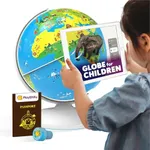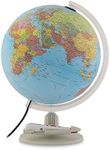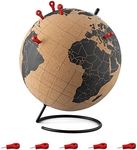Buying Guide for the Best Globe For Kids
Choosing a globe for kids can be an exciting educational opportunity. A globe is not just a decorative item; it is a tool that can spark curiosity about the world, geography, cultures, and more. When selecting a globe for children, it's important to consider factors that will make the globe engaging, educational, and age-appropriate. The right globe can help children visualize the world, understand spatial relationships, and develop a global perspective. Here are some key specifications to consider when choosing a globe for kids.SizeThe size of a globe is measured by its diameter, and it can range from small desktop models to larger floor-standing versions. A smaller globe, around 6 to 12 inches in diameter, is suitable for younger children as it is easier for them to handle and explore. Larger globes, 12 inches or more, provide more detail and are better for older children who can appreciate and understand more complex geographical information. Consider the space where the globe will be used and the child's ability to interact with it when choosing the size.
MaterialGlobes can be made from various materials, including plastic, paper, and metal. Plastic globes are durable and lightweight, making them ideal for young children who might be rough with their toys. Paper globes are often more detailed and can be a good choice for older children who are careful with their belongings. Metal globes are sturdy and can be a stylish addition to a room, but they are heavier and might not be as child-friendly. Consider the child's age and how they will use the globe when selecting the material.
Type of GlobeThere are different types of globes, such as political, physical, illuminated, and interactive globes. Political globes show countries, borders, and cities, which are great for learning about world geography. Physical globes display natural features like mountains and rivers, helping children understand the Earth's topography. Illuminated globes can double as nightlights and are visually appealing, while interactive globes often come with apps or electronic features that provide additional educational content. Choose a type that aligns with the child's interests and learning goals.
Educational FeaturesSome globes come with additional educational features, such as augmented reality, audio guides, or interactive apps. These features can enhance the learning experience by providing more information about different regions, cultures, and historical events. For tech-savvy kids or those who enjoy interactive learning, a globe with these features can be particularly engaging. Consider the child's learning style and interest in technology when deciding if these features are important.
Design and ColorsThe design and colors of a globe can make it more appealing to children. Bright, vibrant colors can attract younger kids and make learning more fun, while older children might appreciate a more realistic or sophisticated design. Some globes also feature animals, landmarks, or other thematic elements that can capture a child's interest. Think about what will engage the child visually and make them excited to explore the globe.















